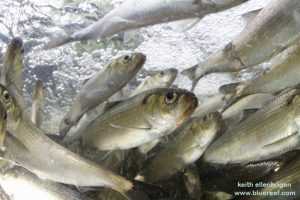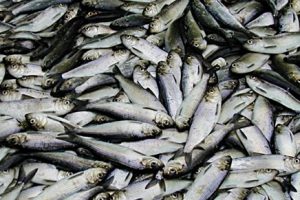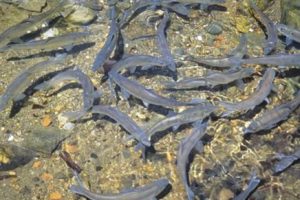What are alewives?
Alewives are anadromous (sea-run) fish that spend the majority of their life at sea but return to freshwater to spawn. Alewives have co-evolved and co-existed with other native fish and wildlife in Maine’s streams, rivers, ponds and lakes for thousands of years. Alewives are members of the herring family; its close cousins are shad and blueback herring. (Sometimes people refer to river herring as an inclusive term that refers to both alewife and blueback herring. Alewives and blueback herring look nearly identical, although there are behavioral and genetic distinctions). Alewives have slender bodies, and they normally grow to 10 – 11″ in length, weighing in at about half a pound. Repeat spawners can be as large as 14 inches and weigh a pound or more. Alewives are grayish green on their back, and silvery on their sides and belly. Just behind their head, they’ve got a single black spot on each side and their tails are forked.
The Rise of the River Herring
Were alewives originally present in our lakes?
The bad news is that many Mainers have probably never even seen an alewife run because Maine’s historically thriving alewife population has plummeted during the last two centuries. Dams, pollution and overfishing have taken their toll, in the familiar sorry story of our state’s native anadromous fish runs. Alewife Brook, for example, doesn’t have alewives in it.
However, historians and scientists tell us that prior to Europeans settling this region, there was probably not a stream anywhere in the Gulf of Maine that didn’t have an annual alewife migration unless it was blocked by impassable falls. Alewife spawning runs, which paved the rivers with silvery fish, ran deep into the lakes and ponds in the inland reaches of the region; even now, the fish journey each spring almost 150 kilometers up the St. John River to the Mactaquac Dam, and then the few that get beyond that dam go upriver another 100 kilometers. One early historian said “No stream seems to be too small for them if its waters are derived from a pond, and there can have been hardly an accessible pond in the whole State they did not visit.”
It’s believed that of all the migratory fish that came up Maine’s rivers, alewives were the most abundant. One history of Gardiner and Pittston, written in 1852, relates that “alewives were so plentiful there at the time the country was settled, that bears, and later swine, fed on them in the water. They were crowded ashore by the thousands.” A number of Maine’s river names include Native references to alewives. The Penobscot word for a single alewife is “madames,” and thus we have Mattamiscontis (Stream), which is a tributary to the Penobscot River, and means “plenty of alewives.”
Before alewife populations declined, native Americans and European settlers depended on the bounty brought to inland waters by spring migrations. When one river town built a dam and blocked the fish from their spawning habitat, one early chronicler wrote that the inhabitants of the next town were outraged. “It was difficult to persuade the aggrieved people to forbear using violence to open a passage for ye fish the cry of the poor every year for want of the fish is enough to move the bowls of compassion in any man that hath not an heart of stone.” In 1809, the selectmen in Benton ordered a mill dam to be torn down because it blocked huge runs of alewives and shad on the Sebasticook River.
The good news is that alewives are relatively easy to restore. Unlike some of the other species of sea run fish, alewives are very congenial about passing up fishways, and with a little bit of help from us, their populations can rebound within a generation (how many years?) This past November, for example, the people of Newport, along with fisheries biologists from all over the state, celebrated the installation of a fishway that provides alewives access to Sebasticook Lake. Gulf of Maine Council on the Marine Environment and the Natural Resources Council of Maine both presented prestigious awards to individuals and organizations involved in the visionary restoration work at Sebasticook Lake. Similarly, this December, many federal, state and local partners in Maine received the Coastal America Partnership Award from President George W. Bush for their collaborative work to remove Smelt Hill Dam on the Presumpscot River and restore sea-run fish – including an estimated 150,000 – 200,000 alewives. And today, the energies and accolades of many federal, state and local representatives are focused on a large-scale effort to restore sea-run fish, including an estimated # million alewives, in the Penobscot River by removing major mainstem dams and installing fish passage facilities.
What is the alewife’s life cycle?
Every May and June, adult alewives, guided by their sense of smell, migrate upstream from the ocean to rivers, streams, ponds and lakes to spawn. Spawning occurs in slack water in ponds and lakes or the quiet backwaters of rivers and streams. Some males return to freshwater when they are three years old. Females usually return when they are four of five years old. One female alewife can produce somewhere between 60,000 to 250,000 eggs, but only a few eggs survive to the juvenile stage, and sometimes only as few as three juveniles survive to adulthood. Adult alewives don’t feed while they migrate upstream and spawn, but they start feeding again during their downstream migration. In freshwater, juvenile and out-migrating adult alewives eat zooplankton, along with some insect larvae and small crustaceans. In the ocean, alewives continue to feed primarily on plankton, and they also consume small fish. Although some adults die after spawning, the majority of adults make their way back to the ocean shortly after spawning–and return the following spring to spawn again.
Once hatched, juvenile alewives remain in freshwater lakes and ponds where they typically feed on zooplankton. The juveniles grow anywhere between 1–6 inches, depending on the productivity of the lake. From mid-July through October, juveniles migrate downstream to the ocean where they grow to adulthood.
Do alewives affect water quality?
Strong scientific evidence to-date makes it clear that alewives do not significantly alter water quality in Maine’s lakes and ponds. It is well-substantiated that the major factor causing algae blooms in our lakes is the introduction of phosphorus. When adult alewives migrate into a freshwater pond or lake, there is an influx of phosphorus to the lake. However, the majority of the spawning alewives return to the ocean, taking phosphorus with them. Additionally, young alewives that grow in freshwater ponds and lakes incorporate phosphorus into their bodies. That phosphorus is removed when the young migrate to the ocean. Consider the general life cycle of alewives – Alewives enter the lake, eat plankton, and then leave the lake — thus exporting lake nutrients. Without alewives in the system, plankton will bloom, die and settle to the bottom to provide nutrients for the lake’s algae bloom the following year.
Comprehensive studies coordinated by Maine DEP in the 1970s on Round Pond and on Lake George in the 1990s, supplemented by less exhaustive studies in # other Maine lakes and ponds demonstrate that when alewives are restored, there is no impact or a minor net decrease in total lake phosphorus. In fact, extensive data points to very good water quality on many lakes with active alewife restoration programs. A little further afield in southeastern Massachusetts, the Assawompsett Pond hosts the largest alewife population in New England (two million adult alewives this past spring). Most of the ponds in this complex have served as public water supplies since about 1900, and water quality and quantity in the ponds is outstanding, even though the ponds are generally very shallow.
Do alewives harm recreational or commercial fishing?
No. In fact, alewives help support recreationally and commercially valuable fish, in freshwater and in the ocean! Alewives – both adults and juveniles are small – and are therefore eaten by many other species of native, introduced, commercially and recreationally important fish. In freshwater, alewives provide important forage for large and small-mouth bass, brown trout and other salmonids. In the estuaries and the ocean, striped bass, cod and haddock feed on alewives, and the recovery of these economically valuable fish will directly benefit from restored populations of alewives. Large numbers of migrating alewives entering our rivers in spring can also provide vital cover for outmigrating Atlantic salmon smolt. In addition, lobstermen depend on alewives as a very important component of their spring lobster bait fishery.
What slightly complicates the picture is the unsubstantiated claim alleging that juvenile alewives consume the majority of large zooplankton in lakes and ponds, at the expense of other freshwater fish species. Frankly, this contention doesn’t make biological sense. Juvenile and returning adult alewives have evolved to take advantage of zooplankton production during the times of year when lakes and ponds are most productive and when zooplankton populations are highest (summer and fall). Alewives leave lakes and ponds when zooplankton production declines in the fall and winter. Therefore, the natural cycles of zooplankton and alewives are coordinated in a way that accommodates alewives, and still supports feeding requirements of all of the resident freshwater fish when the zooplankton population settles back to its fall and winter levels.
A ten-year study conducted by Maine Dept. of Marine Resources, Maine Dept. of Inland Fisheries and Wildlife and Maine Dept. of Environmental Protection showed that at a stocking rate of six adult alewives per acre, there were no detrimental effects to freshwater fish in terms of size or abundance. Young-of-the year smelt and pickerel actually grew better in the presence of alewives! Moreover, many other lakes in ME have thriving alewive that co-exist with healthy populations of other fish (provide some examples ) The Assawompsett Pond complex in southeastern Massachusetts, which hosts the largest alewife population in New England (two million adult alewives this past spring) offers great fishing. According to local fisherman, the ponds support exceptionally robust populations of largemouth and smallmouth bass, crappie, white perch, yellow perch, walleye, pickerel, pike, catfish, suckers, and a variety of baitfish.
How do alewives benefit lakes, rivers, and the ocean?
Nature has reasons for doing everything that it does. And while alewives present a spectacular migration every spring that’s lovely for people to watch, there’s a larger reason that they exist.
For example, in the spring, when alewives move up our rivers, that’s precisely the same time juvenile salmon smolts are moving downriver. If you were a sharp-eyed osprey in a riverside tree, what would you go for? One of the zillions of alewives you see down there, or the few salmon smolt hidden by those alewives? Alewives provide cover for those salmon. In the same way, healthy populations of alewives also provide cover for young salmon parr residing in upriver reaches, for upstream migrating adults that could be attacked by seals or otters, and for young salmon in the estuaries and open ocean.
Another example – The alewife is the only confirmed host for the alewife floater mussel, which lives in Atlantic coastal rivers and lakes. Without the alewife playing host to the floater, the floater won’t be able to get to where it needs to go, and thrive. This is what happened, for example, when alewives were extirpated on rivers where dam construction stopped them from spawning. The alewife floater disappeared as well.
The important message is that alewives tie our ocean, rivers and lakes together, providing vital nutrients and forage needed to make healthy watersheds. Imagine huge schools of alewives that swim in the Gulf of Maine, as far as 120 miles out. Then the adults move, in huge waves, back inshore and up into freshwater. Once they have spawned, adults then migrate back downstream, followed later in the summer and fall by the juveniles. Between and within those various habitats, everything eats alewives: striped bass, bluefish, weakfish, tuna, cod, haddock, halibut, American eel, rainbow- brown- and lake trout, landlocked salmon, smallmouth bass, pickerel, pike, white and yellow perch, seabirds, bald eagle, osprey, great blue heron, gulls, terns, cormorants, seals, whales, otter, mink, fox, raccoon, skunk, weasel, fisher, and turtles. In addition, lobstermen harvest alewives as bait for their spring lobster fishery.
Prepared in 2003 by: Naomi Schalit Executive Director Maine Rivers, Lois Winter Conservation Biologist U.S. Fish and Wildlife Service Gulf of Maine Program, Dr. Gail Wippelhauser Marine Resource Scientist II Maine Dept. of Marine Resources Photo credits to: Doug Watts (migrating alewives) Ethan Nedeau (Damariscotta Lake) All other photos: U.S. Fish and Wildilfe Service NOAA — Fisheries
Click here for a graphical PDF of the above text: “All About Maine Alewives“




